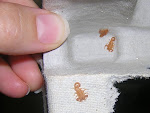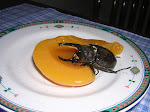My encounters with javelina are fairly regular, always the same: either duck or dodge. They are at once shy (hence, "duck" to get a good picture) and unpredictably aggressive (hence "dodge" upon being charged). I guess the thrill of the chase goes both ways!
Being charged by javelina is not inevitable and bears over-rating (but I dare ya not to dodge!). They are most often happy to move off without any encounter. If happened upon at close range or otherwise startled, they may burst forth in a head-on sprint -- as if suddenly whipped from behind. I have been charged this way many times and to their credit, they always veer at the last minute. I now keep a cautious, albeit curious, eye out when walking home along the dimly-lit path from my night-time work outs, but dodges still occur due to limited views.

It is comforting to know that even in the nation's 4th largest
metropolitan area, ungulates -- not muggers -- are the cautionary visitor.
metropolitan area, ungulates -- not muggers -- are the cautionary visitor.
The javelina venture into the complex for a drink and a nibble, especially during dry stretches. It is not unusual for the Sonoran desert to go more than 2.5+ mos. without measurable rainfall -- tough even for desert-adapted animals. Since our buildings and parking lots replaced their succulent cacti and water-retaining tubers, it's only fair that we share. The javelina's adaption to urban environments is to be celebrated, though not all my neighbors would agree.
It's difficult getting a good picture of javelina, in part because they're primarily nocturnal and emerge well after dark. I've belly-crawled and bush-crouched to no avail. But suddenly, this lovely family of four came to visit below my deck during our recent cold snap.
 Unusual day-time activity... Needed more calories?
Unusual day-time activity... Needed more calories?Perhaps the cold was too exciting to nap through...
Javelina are often mistaken for pigs. Both are grouped in the order Artiodactyla , which includes other even-toed hooved animals (hippos, camels, deer, etc.). Our domestic pigs and wild boar are actually (descended from) European transplants, whereas javelina are native to the New World. Their range is from mid-level South America to the U.S. southwest (AZ, TX, NM). Pigs and javelina began their evolutionary separation more than 30 million years ago, and have many diverging characteristics...
Javelina facts:

Family: Tayassuidae (consists of 3 genera of peccaries)
Neighboring families: Hippopotamidae (hippopotamases) and Suidae (pigs).
Size: up to 22 inches at shoulder, and 3 ft. long; 35-60 lbs (males are larger than females)...smaller than pigs.
Characteristics: covered in bristling hairs; have white vertical band on shoulder; one pair of bottom canines protrude straight upward (whereas with pigs & boar, the canines are curved or lateral).
Social organization: entire life spent in same social group of up to 20 individuals; scent gland on rump helps in identification of group and social hierarchy within group.
Voice: muffled grunts; the young give a loud bark-quack ("bwaak!"), squeals, grunts.
Food: primarily herbivorous: cacti (esp. prickly pear), roots, grass shoots, fruit, nuts; also opportunistic, and will eat eggs, scavenge on garbage, etc.
Reproduction: average 2 young per mating; 1-2 mating cycles per year
Habitat: diverse: javelina inhabit grasslands, deserts and forests in both arid and tropical habitats.
Status: not protected; hunting is allowed at least in Arizona.
Interesting links for more on javelina:
- The Living Desert: The Peccary
- Pigs, Peccaries, and Hippos, The World Conservation Union.
- Arizona Game and Fish Department













+reduced.jpg)

